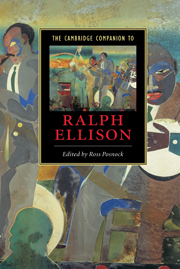Book contents
- Frontmatter
- Introduction
- 1 Ralph Ellison’s invented life
- 2 Ellison and the black Church
- 3 Ellison, photography, and the origins of invisibility
- 4 Ralph Ellison’s music lessons
- 5 Ralph Ellison’s constitutional faith
- 6 Ralph Ellison and the politics of melancholia
- 7 Invisible Ellison
- 8 Ellison’s experimental attitude and the technologies of illumination
- 9 Female iconography in Invisible Man
- 10 Chaos not quite controlled
- 11 Ralph Ellison, Hannah Arendt, and the meaning of politics
- 12 Dry bones
- Selected bibliography and suggestions for further reading
- Index
- Series List
9 - Female iconography in Invisible Man
Published online by Cambridge University Press: 28 May 2006
- Frontmatter
- Introduction
- 1 Ralph Ellison’s invented life
- 2 Ellison and the black Church
- 3 Ellison, photography, and the origins of invisibility
- 4 Ralph Ellison’s music lessons
- 5 Ralph Ellison’s constitutional faith
- 6 Ralph Ellison and the politics of melancholia
- 7 Invisible Ellison
- 8 Ellison’s experimental attitude and the technologies of illumination
- 9 Female iconography in Invisible Man
- 10 Chaos not quite controlled
- 11 Ralph Ellison, Hannah Arendt, and the meaning of politics
- 12 Dry bones
- Selected bibliography and suggestions for further reading
- Index
- Series List
Summary
In 1953, one year after the publication of Ralph Ellison's Invisible Man, Hugh Hefner launched his men's magazine, Playboy. The magazine's centerfold featured a nude Marilyn Monroe posed against a striking red velvet curtain. The photograph was taken in 1949 as Ellison was working diligently on the novel, and it became a quintessential example of American femininity, an icon of American cultural history. As a photographer, art student, and collector of painting and portraiture, Ellison understood the power of visual images. He liked to look at pictures. In his novel, Ellison describes a nude woman that seems to invoke the Playboy image: ''the red robe swept aside like a veil, and I went breathless at the petite and generously curved nude, framed delicate and firm in the glass.'' This nameless woman, ''acting a symbolic role of life and feminine fertility'' (Invisible 409), has a sexual affair with the protagonist and she appears in the novel just as invisible man confronts ''The Woman Question.'' Ellison's artful description of the woman's symbolic role, like Monroe's pose, suggests complicity in a well-known and longstanding iconography of female difference and sexual objectification that critics have argued amounts to nothing more than a literary pinup.
- Type
- Chapter
- Information
- The Cambridge Companion to Ralph Ellison , pp. 172 - 187Publisher: Cambridge University PressPrint publication year: 2005

